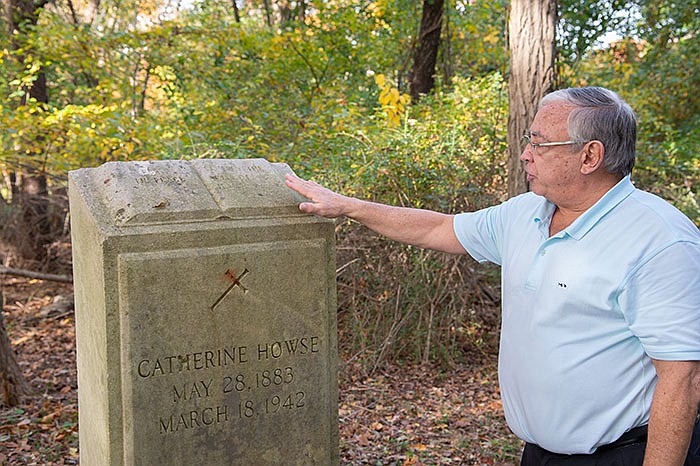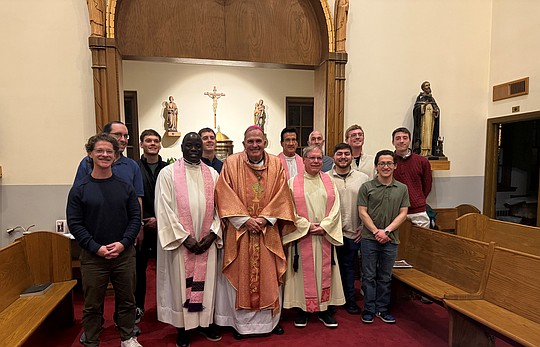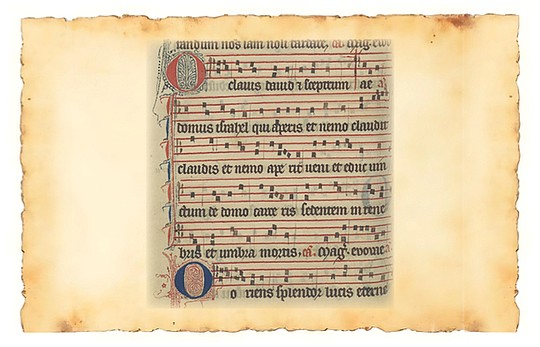Parish, community revitalizing Civil War-era Lincroft cemetery
December 3, 2019 at 1:49 p.m.

It was Memorial Day weekend in 2014 when Joseph Manzi, director of administration and finance for St. Leo the Great Parish, Lincroft, gazed out his office window and saw a well-dressed couple, clutching small American flags, standing at the edge of the woods bordering the parish’s ballfields.
“When I asked them if they needed my help, they told me they had a list of 14 names of soldiers buried in the cemetery and wanted to place flags on their graves,”
Photo Gallery: Civil War-era Lincroft cemetery cleanup
Manzi recalled. “The first thing I thought was, ‘What cemetery?’”
Manzi and the couple attempted to traverse the thick underbrush, he said, “but after a half-hour with no success, we gave up. Then, I literally tripped over a headstone. We resumed, got a bit into the area and found more headstones, two of which were for soldiers who fought in the Civil War.”
Civil War Roots
Manzi later learned that, according to historical research, the neglected plot, about the size of two football fields, was known as the Cedar View Cemetery.
In 1850, James B. Crawford, a wealthy area farmer and former slave holder, sold it for $60 to 14 black men to be used for a burial ground. Subsequent subdivisions of the plot led to more interred souls, perhaps up to 200 men, women and children, and at least 12 militia men serving as what was then the Unites States Colored Troops in the American Civil War. Over the subsequent decades, the township of Lincroft ceded the land and erroneously marked it as part of the Catholic parish.
“You shouldn’t live your life and be forgotten,” Manzi said recently, as he looked out over the brush, leaves and fallen trees hiding the cemetery. “Where’s the respect for life, for what it meant for these people and families who served our country?”
Manzi recalled talking to Father John T. Folchetti, pastor, and urging that “we had a moral obligation to care for the cemetery.” One of the parish’s trustees, Dr. Joelle Zabotka, an assistant professor at Monmouth University’s School of Social Work, realized the plot had historical significance, and the Cedar View Cemetery cleanup project was born.
Since spring 2015, numerous community and ecumenical volunteer organizations have taken responsibility for the cemetery’s care; in addition to St. Leo the Great Parish and Monmouth University volunteers, workers have included members from the Monmouth County Historical Commission; the Middletown Township Landmarks Commission; the African-American Special Interest Group of the Monmouth County Genealogy Society; the Monmouth Garden Club; Pilgrim Baptist Church, Red Bank, and Boy Scout Troop 110 of Lincroft.
‘A Sign of Respect’
During some of the first cleanup weekends, volunteers saw the plot begin to display its roots as a venerated burial ground. Fifteen 30-yard containers were filled with brush by scores of Monmouth University fraternity and sorority members toiling alongside church and townspeople, all eager to unveil a bit of hidden history in their midst.
Vegetative growth and storms necessitate periodic working crews; a recent sunny Saturday morning saw scores of volunteers of all ages carefully trimming back brush, raking leaves, gathering loads of debris into wheelbarrows, and peering at the approximately 50 additional tombstones discovered and carefully set back into place. Chris Cevasco, husband of Dr. Zabotka, served as site manager that morning, directing teens and young adults in their gardening efforts.
Cevasco explained that his son James, a member of Boy Scout Troop 110, had achieved his Eagle status by restoring the entryway of the plot and installing a stairway for visitors into Cedar View Cemetery.
“It’s like walking around the Smithsonian,” the elder Cevasco said with wonder. “Take a minute, read the headstones – these were Civil War veterans. “It’s like finding gold.”
Joan Kret, St. Leo the Great Parish youth ministry coordinator, takes the teens into the cemetery each Veterans Days to clear leaves and adorn the graves of militiamen with American flags.
“With this project, they recognize … what the veterans did for their country,” Kret said. [The youth] love doing things in the community. The planting of the flags to mark the graves is a sign of respect.”
Youth group member Kaitlyn Hanlon described the project as “an amazing experience, because by cleaning up this cemetery, we were also honoring selfless soldiers who sacrificed their lives to save others.”
“It is important to honor those who risked their lives for our freedoms,” said fellow youth ministry member Matthew McLaughlin. “Cleaning up the cemetery is the right thing to do and is an important tribute to those veterans.”
Preserving Dignity
“Today you can see the whole footprint,” Manzi said as he walked carefully over uneven ground. But more intensive and scientific work remains, he noted.
“We are trying to find a company to donate the use of a sonar machine to examine the land and find graves without markers,” he revealed. “Some of these people were poor, and some were indentured servants. So many of the headstones were made of wood and have eroded. I feel bad we may be standing on graves without identification.”
One of the cemetery’s most recent graves is that of Catherine Howse, interred in 1942. Her five-foot-tall concrete headstone, eroded by time, was topped by an open Bible with the left page reading “Rest in Peace,” and the words on the right obscured by time and the elements. Not far away was what volunteers have dubbed “the nursery,” a grouping of three tiny headstones signifying the final resting place of three children, all younger than two years old, who died in the late 1800s.
As he spoke, Manzi leaned over and carefully scraped away decades of dirt from a gravestone to reveal “James Bowles, Co. B, 41st U.S. Colored Troops, 1833-1916.” Nearby was the gravesite of the soldier’s late wife, Delia.
Manzi reflected, “These hundreds of lives should never have been neglected. We must bring back their dignity and sanctity. They should not be forgotten.”
For more information about the Cedar View Cemetery cleanup, or to donate funds, see the St. Leo the Great Parish website at stleothegreat.com, or contact Joseph Manzi at 732-747-5466.
Related Stories
Monday, December 15, 2025
E-Editions
Events
It was Memorial Day weekend in 2014 when Joseph Manzi, director of administration and finance for St. Leo the Great Parish, Lincroft, gazed out his office window and saw a well-dressed couple, clutching small American flags, standing at the edge of the woods bordering the parish’s ballfields.
“When I asked them if they needed my help, they told me they had a list of 14 names of soldiers buried in the cemetery and wanted to place flags on their graves,”
Photo Gallery: Civil War-era Lincroft cemetery cleanup
Manzi recalled. “The first thing I thought was, ‘What cemetery?’”
Manzi and the couple attempted to traverse the thick underbrush, he said, “but after a half-hour with no success, we gave up. Then, I literally tripped over a headstone. We resumed, got a bit into the area and found more headstones, two of which were for soldiers who fought in the Civil War.”
Civil War Roots
Manzi later learned that, according to historical research, the neglected plot, about the size of two football fields, was known as the Cedar View Cemetery.
In 1850, James B. Crawford, a wealthy area farmer and former slave holder, sold it for $60 to 14 black men to be used for a burial ground. Subsequent subdivisions of the plot led to more interred souls, perhaps up to 200 men, women and children, and at least 12 militia men serving as what was then the Unites States Colored Troops in the American Civil War. Over the subsequent decades, the township of Lincroft ceded the land and erroneously marked it as part of the Catholic parish.
“You shouldn’t live your life and be forgotten,” Manzi said recently, as he looked out over the brush, leaves and fallen trees hiding the cemetery. “Where’s the respect for life, for what it meant for these people and families who served our country?”
Manzi recalled talking to Father John T. Folchetti, pastor, and urging that “we had a moral obligation to care for the cemetery.” One of the parish’s trustees, Dr. Joelle Zabotka, an assistant professor at Monmouth University’s School of Social Work, realized the plot had historical significance, and the Cedar View Cemetery cleanup project was born.
Since spring 2015, numerous community and ecumenical volunteer organizations have taken responsibility for the cemetery’s care; in addition to St. Leo the Great Parish and Monmouth University volunteers, workers have included members from the Monmouth County Historical Commission; the Middletown Township Landmarks Commission; the African-American Special Interest Group of the Monmouth County Genealogy Society; the Monmouth Garden Club; Pilgrim Baptist Church, Red Bank, and Boy Scout Troop 110 of Lincroft.
‘A Sign of Respect’
During some of the first cleanup weekends, volunteers saw the plot begin to display its roots as a venerated burial ground. Fifteen 30-yard containers were filled with brush by scores of Monmouth University fraternity and sorority members toiling alongside church and townspeople, all eager to unveil a bit of hidden history in their midst.
Vegetative growth and storms necessitate periodic working crews; a recent sunny Saturday morning saw scores of volunteers of all ages carefully trimming back brush, raking leaves, gathering loads of debris into wheelbarrows, and peering at the approximately 50 additional tombstones discovered and carefully set back into place. Chris Cevasco, husband of Dr. Zabotka, served as site manager that morning, directing teens and young adults in their gardening efforts.
Cevasco explained that his son James, a member of Boy Scout Troop 110, had achieved his Eagle status by restoring the entryway of the plot and installing a stairway for visitors into Cedar View Cemetery.
“It’s like walking around the Smithsonian,” the elder Cevasco said with wonder. “Take a minute, read the headstones – these were Civil War veterans. “It’s like finding gold.”
Joan Kret, St. Leo the Great Parish youth ministry coordinator, takes the teens into the cemetery each Veterans Days to clear leaves and adorn the graves of militiamen with American flags.
“With this project, they recognize … what the veterans did for their country,” Kret said. [The youth] love doing things in the community. The planting of the flags to mark the graves is a sign of respect.”
Youth group member Kaitlyn Hanlon described the project as “an amazing experience, because by cleaning up this cemetery, we were also honoring selfless soldiers who sacrificed their lives to save others.”
“It is important to honor those who risked their lives for our freedoms,” said fellow youth ministry member Matthew McLaughlin. “Cleaning up the cemetery is the right thing to do and is an important tribute to those veterans.”
Preserving Dignity
“Today you can see the whole footprint,” Manzi said as he walked carefully over uneven ground. But more intensive and scientific work remains, he noted.
“We are trying to find a company to donate the use of a sonar machine to examine the land and find graves without markers,” he revealed. “Some of these people were poor, and some were indentured servants. So many of the headstones were made of wood and have eroded. I feel bad we may be standing on graves without identification.”
One of the cemetery’s most recent graves is that of Catherine Howse, interred in 1942. Her five-foot-tall concrete headstone, eroded by time, was topped by an open Bible with the left page reading “Rest in Peace,” and the words on the right obscured by time and the elements. Not far away was what volunteers have dubbed “the nursery,” a grouping of three tiny headstones signifying the final resting place of three children, all younger than two years old, who died in the late 1800s.
As he spoke, Manzi leaned over and carefully scraped away decades of dirt from a gravestone to reveal “James Bowles, Co. B, 41st U.S. Colored Troops, 1833-1916.” Nearby was the gravesite of the soldier’s late wife, Delia.
Manzi reflected, “These hundreds of lives should never have been neglected. We must bring back their dignity and sanctity. They should not be forgotten.”
For more information about the Cedar View Cemetery cleanup, or to donate funds, see the St. Leo the Great Parish website at stleothegreat.com, or contact Joseph Manzi at 732-747-5466.










